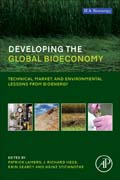
Developing the Global Bioeconomy: Technical, Market, and Environmental Lessons from Bioenergy
Lamers, Patrick
Searcy, Erin
Hess, J. Richard
Stichnothe, Heinz
Developing the Global Bioeconomy: Technical, Market, and Environmental Lessons from Bioenergy brings together expertise from three IEA-Bioenergy subtasks on pyrolysis, international trade, and biorefineries to review the bioenergy sector and draw useful lessons for the full deployment of the bioeconomy. Despite the vast amount of politically driven strategies, there is little understanding on how current markets will transition towards a global bioeconomy. The question is not only how the bioeconomy can be developed, but also how it can be developed sustainably in terms of economic and environmental concerns. To answer this question, this book's expert chapter authors seek to identify the types of biorefineries that are expected to be implemented and the types of feedstock that may be used. They also provide historical analysis of the developments of biopower and biofuel markets, integration opportunities into existing supply chains, and the conditions that would need to be created and enhanced to achieve a global biomass trade system that could support a global bioeconomy. As expectations that a future bioeconomy will rely on a series of tradable commodities, this book provides a central accounting of the state of the discussion in a multidisciplinary approach that is ideal for research and academic experts, and analysts in all areas of the bioenergy, biofuels, and bioeconomy sectors, as well as those interested in energy policy and economics. Examines the lessons learned by the bioenergy industry and how they can be applied to the full development of the bioeconomyExplores different transition strategies and how the current fossil based and future bio-based economy are intertwinedReviews the status of current biomass conversion pathwaysPresents an historical analysis of the developments of biopower and biofuel markets, integration opportunities into existing supply chains, and the conditions that would need to be created and enhanced to achieve a global biomass trade system INDICE: 1. Bioeconomy Strategies J.R. Hess, P. Lamers, H. Stichnothe, M. Beermann and G. Jungmeier 1.1 Introduction 1.2 Status of Bioeconomy Strategies in IEA Bioenergy Member Countries 1.3 Scope, Objective, and Outline 2. Development of Second-Generation Biorefineries H. Stichnothe, H. Storz, D. Meier, I. de Bari and S. Thomas 2.1 Introduction 2.2 Technology and Feedstock Matrix 2.3 Summary 3. Biorefineries: Industry Status and Economics H. Stichnothe, D. Meier and I. de Bari 3.1 Introduction 3.2 Economics 3.3 Demonstration and Full-Scale Plants 3.4 Summary and Outlook 4. Sustainability Considerations for the Future Bioeconomy R. Diaz-Chavez, H. Stichnothe and K. Johnson 4.1 Introduction 4.2 Overview of Methodologies and Sustainability Assessment Frameworks 4.3 Lessons Learned From First-Generation Biofuels and Bioenergy Crops 4.4 Sustainability Assessment Challenges 4.5 Considerations for Future Assessments in the Bioeconomy Sector 4.6 Conclusions and Recommendations 5. Biomass Supply and Trade Opportunities of Preprocessed Biomass for Power Generation B. Batidzirai, M. Junginger, M. Klemm, F. Schipfer and D. Thrän 5.1 Introduction 5.2 International Trade and Supply Opportunities of Processed Stable Biomass Intermediates for Biopower Market 5.3 Local/Regional Trade and Supply Opportunities of Raw Biomass for Bioenergy Market 5.4 Conclusions 6. Commodity-Scale Biomass Trade and Integration with Other Supply Chains E. Searcy, P. Lamers, M. Deutmeyer, T. Ranta, B. Hektor, J. Heinimö, E. Trømborg and M. Wild 6.1 Introduction 6.2 Evolution of Commoditized Biomass 6.3 Current Commodity-Scale Biomass Trade 6.4 The Integration of Commoditized Biomass with Other Commodity Supply Chains 6.5 Future Trends, Recommendation, and Conclusion 7. Commoditization of Biomass Markets O. Olsson, P. Lamers, F. Schipfer and M. Wild 7.1 Introduction 7.2 Defining Commodities 7.3 Commoditization Example: The Case of the Crude Oil Market 7.4 Commoditization of Biomass Markets 7.5 Biomass Commoditization: The Way Forward 8. Transition Strategies: Resource Mobilization Through Merchandisable Feedstock Intermediates P. Lamers, E. Searcy and J.R. Hess 8.1 Objective and Link to Previous Chapters 8.2 Challenges Within Large-Scale Biorefinery Feedstock Supply Chains 8.3 Feedstock Supply System Types: Conventional and Advanced 8.4 Depot Configurations and Evolvement 8.5 Depot Deployment 8.6 Market Transition 8.7 Conclusions Conclusions P. Lamers, E. Searcy, J.R. Hess and H. Stichnothe
- ISBN: 978-0-12-805165-8
- Editorial: Academic Press
- Encuadernacion: Rústica
- Páginas: 220
- Fecha Publicación: 23/06/2016
- Nº Volúmenes: 1
- Idioma: Inglés
